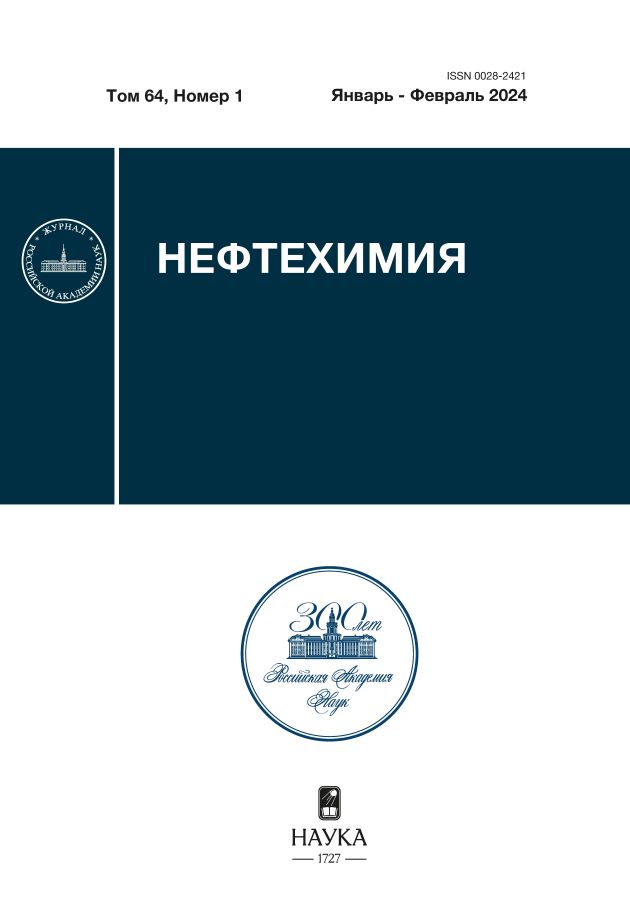Зависимость селективности гидрирования фурфурола в присутствии рутениевых катализаторов от типа их носителя и параметров реакции
- Авторлар: Бороноев М.П.1, Шакиров И.И.1, Ролдугина Е.А.1, Кардашева Ю.С.1, Верченко В.Ю.1, Кардашев С.В.1
-
Мекемелер:
- Московский государственный университет имени М. В. Ломоносова
- Шығарылым: Том 64, № 1 (2024)
- Беттер: 86-96
- Бөлім: Articles
- URL: https://edgccjournal.org/0028-2421/article/view/655571
- DOI: https://doi.org/10.31857/S0028242124010086
- EDN: https://elibrary.ru/OIIKJY
- ID: 655571
Дәйексөз келтіру
Аннотация
Синтезированы катализаторы на основе наночастиц Ru, нанесенных на следующие носители: наносферический мезопористый фенолформальдегидный полимер; мезопористый цирконосиликат; композитный материал на основе мезопористых углеродных наносфер и цирконосиликата. Катализаторы испытаны в гидрировании фурфурола в воде при температурах 100–250°С и давлении водорода 1–5 МПа. Установлено влияние загрузки катализатора и времени реакции на конверсию и селективность процесса. Показано, что катализатор на основе композитного материала обладает более высокой активностью и селективностью в воднофазном гидрировании фурфурола.
Толық мәтін
Авторлар туралы
Максим Бороноев
Московский государственный университет имени М. В. Ломоносова
Хат алмасуға жауапты Автор.
Email: maxbv04@gmail.com
ORCID iD: 0000-0001-6129-598X
н.с., химический факультет
Ресей, Москва, 119991Искандер Шакиров
Московский государственный университет имени М. В. Ломоносова
Email: maxbv04@gmail.com
ORCID iD: 0000-0003-2029-693X
химический факультет
Ресей, Москва, 119991Екатерина Ролдугина
Московский государственный университет имени М. В. Ломоносова
Email: maxbv04@gmail.com
ORCID iD: 0000-0002-9194-1097
к.х.н., химический факультет
Ресей, Москва, 119991Юлия Кардашева
Московский государственный университет имени М. В. Ломоносова
Email: maxbv04@gmail.com
ORCID iD: 0000-0002-6580-1082
к.х.н., химический факультет
Ресей, Москва, 119991Валерий Верченко
Московский государственный университет имени М. В. Ломоносова
Email: maxbv04@gmail.com
ORCID iD: 0000-0002-8000-425X
к.х.н., химический факультет
Ресей, Москва, 119991Сергей Кардашев
Московский государственный университет имени М. В. Ломоносова
Email: maxbv04@gmail.com
ORCID iD: 0000-0003-1818-7697
к.х.н., химический факультет
Ресей, Москва, 119991Әдебиет тізімі
- Zaera F. Nanostructured materials for applications in heterogeneous catalysis // Chem. Soc. Rev. 2013. V. 42 № 7. P. 2746–2762. https://doi.org/10.1039/C2CS35261C
- Verma P., Kuwahara Y., Mori K., Raja R., Yamashita H. Functionalized mesoporous SBA-15 silica: recent trends and catalytic applications // Nanoscale. 2020. V. 12. № 21. P. 11333–11363. https://doi.org/10.1039/D0NR00732C
- Perego C., Millini R. Porous materials in catalysis: challenges for mesoporous materials // Chem. Soc. Rev. 2013. V. 42. № 9. P. 3956–3976. https://doi.org/10.1039/C2CS35244C
- Muylaert I., Verberckmoes A., De Decker J., Van Der Voort P. Ordered mesoporous phenolic resins: highly versatile and ultra stable support materials // Adv. Colloid Interface Sci. 2012. V. 175. P. 39–51. https://doi.org/10.1016/j.cis.2012.03.007
- Zhu H., Maheswari R., Ramanathan A., Subramaniam B. Evaporation-induced self-assembly of mesoporous zirconium silicates with tunable acidity and facile catalytic dehydration activity // Micropor. Mesopor. Mat. 2016. V. 223 P. 46–52. https://doi.org/10.1016/j.micromeso.2015.10.026
- Yu Z., Tian H., Sun K., Shao Y., Zhang L., Zhang S., Duan P., Liu Q., Niu S., Dong D., Hu X. Impacts of externally added Brønsted and Lewis acid on conversion of furfural to cyclopentanone over Ni/SiC catalyst // Mol. Cat. 2020. V. 496. ID. 111187. https://doi.org/10.1016/j.mcat.2020.111187
- Rayner G.B., Jr., Kang D., Lucovsky G. Spectroscopic study of chemical phase separation in zirconium silicate alloys // J. Vac. Sci. Technol. B: Microelectron. Nanometer Struct. Process Meas. Phenom. 2003. V. 21. № 4. P. 1783–1791.
- Podyacheva O.Y., Bulushev D.A., Suboch A.N., Svintsitskiy D.A., Lisitsyn A.S., Modin E., Chuvilin A., Gerasimov E.Y., Sobolev V.I., Parmon V.N. Highly stable single-atom catalyst with ionic Pd active sites supported on N-doped carbon nanotubes for formic acid decomposition // ChemSusChem. 2018. V. 11. № 21. P. 3724–3727. https://doi.org/10.1002/cssc.201801679
- Mason M.G. Electronic structure of supported small metal clusters // Phys. Rev. B. 1983. V. 27. № 2. P. 748–762. https://link.aps.org/doi/10.1103/PhysRevB.27.748
- Zhang F., Liang C., Wu X., Li H. A nanospherical ordered mesoporous Lewis acid polymer for the direct glycosylation of unprotected and unactivated sugars in water // Angew. Chem., Int. Ed. Engl. 2014. V. 53. № 32. P. 8498–8502. https://doi.org/10.1002/anie.201404353
- Choy J.H., Yoon J.B., Jung H., Park J.H. Zr K-Edge XAS and 29 Si MAS NMR studies on hexagonal mesoporous zirconium silicate // J. of Porous Mater. 2004. V. 11. P. 123–129. https://doi.org/10.1023/B: JOPO.0000038007.82949.e
- Meng Y., Gu D., Zhang F., Shi Y., Yang H., Li Z., Yu C., Tu B., Zhao D. Ordered mesoporous polymers and homologous carbon frameworks: amphiphilic surfactant templating and direct transformation // Angew. Chem. Int. Ed. 2005. V. 44. № 43. P. 7053–7059. https://doi.org/10.1002/anie.200501561
- Rayner G.B., Kang D., Hinkle C.L., Hong J.G., Lucovsky G. Chemical phase separation in Zr silicate alloys: a spectroscopic study distinguishing between chemical phase separation with different degree of micro- and nano-crystallinity // Microelectron. Eng. 2004. V. 72. № 1. P. 304–309. https://doi.org/10.1016/j.mee.2004.01.008
- Li Y.S., Wong P.C., Mitchell K.A.R. XPS investigations of the interactions of hydrogen with thin films of zirconium oxide II. Effects of heating a 26 Å thick film after treatment with a hydrogen plasma // Appl. Surf. Sci. 1995. V. 89. № 3. P. 263–269. https://doi.org/10.1016/0169-4332(95)00032-1
- Yue Z.R., Jiang W., Wang L., Gardner S.D., Pittman C.U. Surface characterization of electrochemically oxidized carbon fibers // Carbon. 1999. V. 37. № 11. P. 1785–1796. https://doi.org/10.1016/S0008-6223(99)00047-0
- Morgan D.J. Resolving ruthenium: XPS studies of common ruthenium materials // Surf. Interface Anal. 2015. V. 47. № 11. P. 1072–1079. https://doi.org/10.1002/sia.5852
- Okal J. The interaction of oxygen with high loaded Ru/γ-Al2O3 catalyst // Mater. Res. Bull. 2009. V. 44. № 2. P. 318–323. https://doi.org/10.1016/j.materresbull.2008.05.018
- Barzetti T., Selli E., Moscotti D., Forni L. Pyridine and ammonia as probes for FTIR analysis of solid acid catalysts // J. Chem. Soc. Faraday Trans. 1996. V. 92. № 8. P. 1401–1407. https://doi.org/10.1039/FT9969201401
- Panagiotopoulou P., Vlachos D.G. Liquid phase catalytic transfer hydrogenation of furfural over a Ru/C catalyst // Appl. Catal. A. 2014. V. 480. P. 17–24. https://doi.org/10.1016/j.apcata.2014.04.018
- Swift T.D., Nguyen H., Erdman Z., Kruger J.S., Nikolakis V., Vlachos D.G. Tandem Lewis acid/Brønsted acid-catalyzed conversion of carbohydrates to 5-hydroxymethylfurfural using zeolite beta // J. of Catal. 2016. V. 333. P. 149–161. https://doi.org/10.1016/j.jcat.2015.10.009
Қосымша файлдар




















